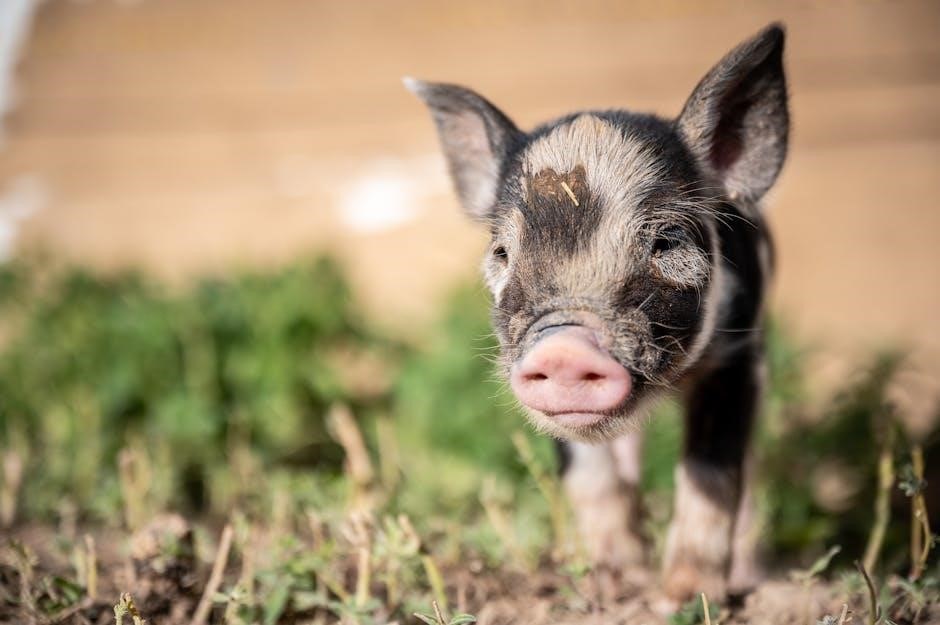The Three Little Pigs is a beloved fairy tale by Joseph Jacobs, teaching moral lessons through the adventures of three pigs and a hungry wolf.
1.1 Overview of the Three Little Pigs
The Three Little Pigs is a classic fairy tale about three pigs who leave home to seek their fortunes. Each pig builds a house—of straw, sticks, and bricks—representing different levels of effort and wisdom. A hungry wolf tries to blow down their houses, succeeding with the first two but failing with the strongest brick house. The story, first published by Joseph Jacobs in 1890, emphasizes preparation, hard work, and cleverness as key virtues, making it a timeless moral lesson for children.
1.2 Importance of the Story in Children’s Literature
The Three Little Pigs holds a significant place in children’s literature for its moral lessons and engaging narrative. It teaches the importance of hard work, preparation, and wisdom through simple, relatable storytelling. The tale is widely used in education to promote critical thinking and ethical values, making it a cornerstone of childhood learning and development. Its timeless themes ensure its relevance across generations, fostering both entertainment and enlightenment for young readers.

Plot Summary
The Three Little Pigs tells the story of three pigs who build houses of straw, sticks, and bricks to protect themselves from a hungry wolf.
2.1 The Departure of the Three Little Pigs
The story begins with three little pigs leaving their mother’s home to seek their fortunes. Their mother advises them to work hard and do their best. The pigs set out on their journey, eager to build their own houses and start new lives. This departure marks the beginning of their adventures and the lessons they will learn along the way.
2.2 Building the Houses (Straw, Sticks, and Bricks)
The three little pigs each built houses using different materials. The first pig quickly constructed a straw house, prioritizing speed over strength. The second pig chose sticks, believing it to be a safer option. The third pig, however, dedicated time and effort to build a sturdy brick house, demonstrating wisdom and foresight. Their choices reflected their varying levels of preparation and responsibility.
2.3 The Big Bad Wolf’s Attempt to Blow Down the Houses
The Big Bad Wolf targeted the three little pigs, determined to blow down their houses. He easily destroyed the straw and stick houses with his powerful huffs and puffs. However, the brick house stood firm, thwarting the wolf’s attempts. This dramatic sequence showcased the consequences of the pigs’ choices, highlighting the importance of resilience and preparation in overcoming adversity. The wolf’s relentless efforts added suspense to the story, keeping readers engaged.
2.4 The Climactic Ending and Moral Lesson
The story reaches its climax as the Big Bad Wolf fails to blow down the brick house. The three little pigs escape unharmed, while the wolf meets a dramatic end. This ending emphasizes the importance of hard work, preparation, and wisdom. The moral lesson teaches children that diligence and planning lead to safety and success, while laziness and shortcuts can result in failure. The story concludes with a clear message about responsibility and foresight.

Moral Lessons and Teachings
The story emphasizes the importance of hard work, preparation, and wisdom. It teaches that laziness leads to consequences, while diligence ensures safety and success. Responsibility and foresight are key.
3.1 The Importance of Hard Work and Preparation
The story highlights the significance of hard work and preparation through the third little pig. His diligence in building a sturdy brick house ensured his safety, while the first two pigs’ laziness led to their downfall. This teaches that effort and foresight are essential for overcoming challenges and achieving long-term success, serving as a timeless life lesson for readers of all ages.
3.2 The Consequences of Laziness
The story illustrates the dangers of laziness through the first two pigs. Their quick, poorly constructed houses of straw and sticks were easily destroyed by the wolf. This highlights how a lack of effort and urgency can lead to severe consequences, teaching children the importance of responsibility and diligence in their actions to avoid similar outcomes in life.
3.3 The Value of Wisdom and Planning
The third pig exemplifies wisdom and foresight by constructing a sturdy brick house. This preparation ensures his survival when the wolf attacks, unlike his brothers. The story teaches children that planning and using intelligence can overcome challenges, emphasizing the rewards of thoughtful decision-making and hard work to build a secure and stable foundation for the future;
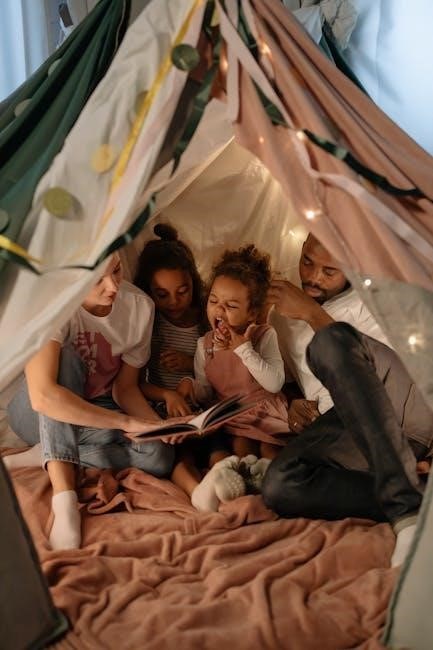
Characters in the Story
The story features three little pigs, each with distinct personalities, their mother, and the antagonist, the Big Bad Wolf. These characters drive the narrative and its moral lessons.
4.1 The First Little Pig (Straw House)
The first little pig is often portrayed as lazy and careless. He quickly builds his house out of straw, prioritizing speed over safety. This decision reflects his lack of foresight and preparation, making him vulnerable to the Big Bad Wolf. His actions serve as a cautionary tale about the consequences of laziness and the importance of hard work. His house is easily destroyed, leading to dire outcomes.
4.2 The Second Little Pig (Stick House)
The second little pig, while slightly more ambitious than his brother, still takes shortcuts. He builds his house with sticks, believing it to be stronger than straw. However, the Big Bad Wolf easily demolishes it with a stronger puff. This teaches that half-hearted efforts may not suffice, as the wolf’s persistence overpowers his mediocre preparation. The second pig narrowly escapes to the safety of his brother’s brick house, highlighting the need for diligence and proper planning to ensure true safety and security.
4.3 The Third Little Pig (Brick House)
The third little pig, being the most prudent, decided to build his house with bricks, recognizing the importance of strength and durability. His foresight and hard work paid off when the wolf attempted to blow down his house but failed. The brick house stood firm, providing a safe refuge for all three pigs. This character exemplifies wisdom, preparation, and the rewards of diligent effort, making him the hero of the story.
4.4 The Big Bad Wolf (Antagonist)
The Big Bad Wolf is the menacing antagonist of the story, whose greed and cunning drive the plot. He relentlessly pursues the three little pigs, seeking to satisfy his hunger by blowing down their houses. His determination and clever tactics create tension, testing the pigs’ preparedness. Ultimately, his failure to destroy the brick house highlights his defeat and serves as a cautionary tale about the consequences of evil intentions and the triumph of good over evil.
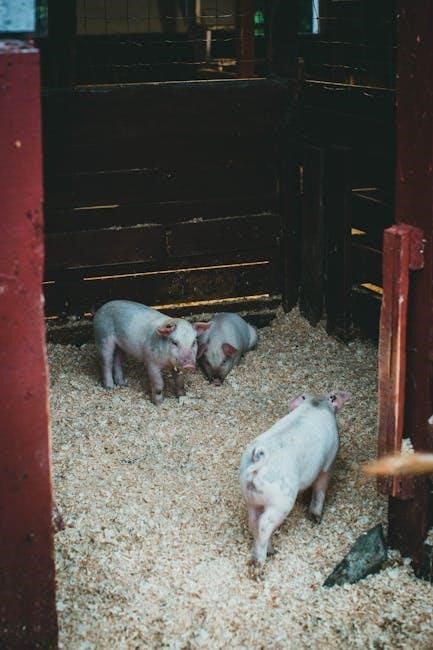
Versions and Adaptations
The Three Little Pigs story has evolved into multiple versions, including modern retellings, cultural adaptations, and educational formats like PDFs, ensuring its timeless appeal to diverse audiences.
5.1 The Original Folk Tale
The original folk tale of the Three Little Pigs was first published by Joseph Jacobs in 1890, featuring a wolf as the antagonist and three pigs who build houses of straw, sticks, and bricks. The story emphasizes moral lessons about hard work and preparation while providing entertainment for children. Its simplicity and timeless themes have made it a classic in children’s literature, widely available in PDF formats for easy access and reading.
5.2 Modern Adaptations of the Story
Modern adaptations of the Three Little Pigs story have evolved to captivate new audiences while retaining its timeless moral lessons. From animated films to stage plays, the tale has been reimagined with fresh twists, such as the addition of musical elements or comedic dialogue. Digital versions, including interactive PDFs, now offer enhanced storytelling experiences. These adaptations ensure the story remains relevant and engaging for contemporary children and educators alike, blending tradition with innovation.
5.3 Cultural Variations of the Three Little Pigs
The Three Little Pigs story has been adapted across various cultures, offering unique twists while maintaining its core moral lessons. In some versions, the characters are replaced with local animals, such as foxes or wolves, reflecting cultural preferences. Additionally, the materials used for building houses may vary, incorporating regional materials like mud or bamboo. These adaptations highlight the story’s universal appeal and its ability to resonate with diverse audiences worldwide;

Themes and Symbolism
The story explores themes of hard work, laziness, and wisdom, symbolized by the houses of straw, sticks, and bricks, highlighting the importance of preparation and prudence.
6.1 The Symbolism of the Three Houses
The three houses—straw, sticks, and bricks—symbolize the consequences of varying levels of effort and planning. The straw house represents laziness and recklessness, while the brick house embodies diligence and wisdom. These structures serve as visual metaphors for the importance of preparation and the dangers of taking shortcuts in life. They reinforce the moral lesson that hard work and foresight lead to safety and success.
6.2 The Representation of Good vs. Evil
The story vividly portrays the struggle between good and evil through its characters. The three little pigs symbolize innocence, hard work, and wisdom, while the big bad wolf represents cunning and evil intentions. The wolf’s attempts to destroy their homes and eat them highlight the classic battle between virtue and malice, emphasizing moral values and the ultimate triumph of good over evil through perseverance and cleverness;
6.3 The Theme of Survival and Perseverance
The story highlights the theme of survival and perseverance through the pigs’ struggles against the wolf. The first two pigs fail due to their haste, while the third pig survives by preparing a strong brick house. This teaches the importance of perseverance and preparedness in overcoming challenges. The pigs’ determination to outsmart the wolf exemplifies how hard work and resilience lead to safety and success, making it a timeless lesson for readers of all ages.

Educational Value
The Three Little Pigs story is a valuable teaching tool, promoting moral lessons, critical thinking, and language skills in children through its engaging narrative and relatable characters.
7.1 Teaching Children Through Storytelling
Storytelling is a powerful tool for educating children, as seen in The Three Little Pigs. The narrative engages young minds, teaching moral lessons like preparation and perseverance. The story’s relatable characters and simple plot make it ideal for early learning, fostering critical thinking and language skills. Interactive activities, such as reading the PDF version, further enhance comprehension and creativity, making it a valuable resource for both parents and educators.
7.2 Using the Story for Moral Education
The Three Little Pigs is a timeless tale that serves as an effective tool for moral education. It teaches children the importance of hard work, preparation, and wisdom, while highlighting the consequences of laziness. The story’s clear moral lessons, such as “do the best you can,” help children develop a strong sense of responsibility. The availability of the story in PDF format makes it easily accessible for parents and educators to use in teaching these valuable life lessons to young minds.
7.3 Incorporating the Story into School Curriculums
The Three Little Pigs story is widely used in schools due to its engaging narrative and moral lessons. Teachers incorporate the tale into curriculums to teach critical thinking, responsibility, and planning. The PDF version of the story is particularly popular, as it allows for easy distribution and interactive learning activities. Its suitability for various age groups makes it a versatile tool for fostering both literacy and moral education in classroom settings.

Availability of the Story in PDF Format
The Three Little Pigs story is easily accessible in PDF format online. Popular websites like Free Kids Books and Digital Library SJKC Chee Chuin offer free downloads, making it convenient for parents and educators to access and print the story for children.
8.1 Free Download Options for the PDF
Free PDF versions of The Three Little Pigs are widely available online. Websites like Free Kids Books and Digital Library SJKC Chee Chuin offer downloadable PDFs; These files are suitable for children and educators, providing an accessible way to enjoy the story. Parents can easily print or share the PDF with their kids, ensuring the timeless tale reaches new generations. The downloads are quick and require minimal effort, making them a convenient choice for storytelling sessions.
8.2 Popular Websites Offering the Three Little Pigs PDF
Popular websites offering free Three Little Pigs PDF downloads include Free Kids Books, Digital Library SJKC Chee Chuin, and educational platforms like Starfall. These sites provide high-quality, downloadable versions of the story, suitable for schools and home use. Parents and educators can access these resources easily, ensuring the tale remains accessible to children worldwide. The PDFs are often accompanied by engaging illustrations and activities, enhancing the learning experience for young readers.
8.3 Benefits of Reading the Story in PDF Format
Reading The Three Little Pigs in PDF format offers convenience, portability, and accessibility. The story can be downloaded and read offline, making it ideal for classrooms or bedtime. PDFs retain vibrant illustrations and formatting, enhancing the visual experience for children. Additionally, the concise 4-minute reading time and interactive elements in some versions make it engaging for young learners. This format ensures the story is easily shareable and adaptable for educational purposes, preserving its timeless appeal.
Activities and Crafts
Engage kids with DIY crafts like building pig and wolf figures, creating house models, and drawing story scenes. Educational worksheets and interactive games enhance learning fun!
9.1 DIY Crafts Inspired by the Story
DIY crafts bring the story to life! Kids can craft straw, stick, and brick houses using cardboard, glue, and paint. Create pig and wolf figures with paper plates or clay. Encourage creativity by making story-themed puppets for role-playing. These activities help children engage with the narrative while developing fine motor skills and imagination. They also serve as fun tools for retelling the story in unique ways. Such crafts are both educational and entertaining, making learning interactive and memorable for young minds. Parents and teachers can easily access these ideas online, with many resources offering step-by-step guides and materials lists. By participating in these DIY projects, children not only enjoy the process but also gain a deeper understanding of the story’s themes and moral lessons. Additionally, these crafts can be displayed in classrooms or at home, fostering a sense of pride and accomplishment in their creative work. Overall, DIY crafts inspired by The Three Little Pigs are a wonderful way to extend the learning experience beyond the story itself, promoting creativity, critical thinking, and hands-on learning.
9.2 Educational Worksheets Based on the Three Little Pigs
Educational worksheets inspired by The Three Little Pigs are a great way to enhance learning. These resources include activities like sequencing the story, matching games, and comprehension exercises. Worksheets focus on skills such as literacy, numeracy, and problem-solving. They are designed for children to engage with the story while practicing essential skills. Many worksheets are available in PDF format, making them easy to download and print for classroom or home use. These tools are perfect for teachers and parents seeking to integrate the story into lesson plans, promoting both fun and education; By using these worksheets, children can deepen their understanding of the narrative while developing critical thinking abilities. Additionally, they often include creative elements like drawing sections, allowing kids to express their imagination. Overall, educational worksheets based on The Three Little Pigs offer a comprehensive and interactive learning experience tailored for young students.
9.3 Interactive Games Related to the Story
Interactive games based on The Three Little Pigs engage children in fun learning experiences. These include matching games, sequencing activities, and puzzles that reinforce story comprehension. Online platforms offer digital versions, while printable PDFs provide offline options. Games often focus on skills like problem-solving and memory, making them both entertaining and educational. They are ideal for classrooms and homes, encouraging active participation and creativity while exploring the story’s themes. Many games are designed for various age groups, ensuring accessibility for all learners. By integrating gameplay with storytelling, these activities help children develop critical thinking and motor skills in an enjoyable way. They also foster teamwork when played in groups, enhancing social interaction. Overall, interactive games related to The Three Little Pigs are a dynamic way to extend the story’s educational value and appeal.
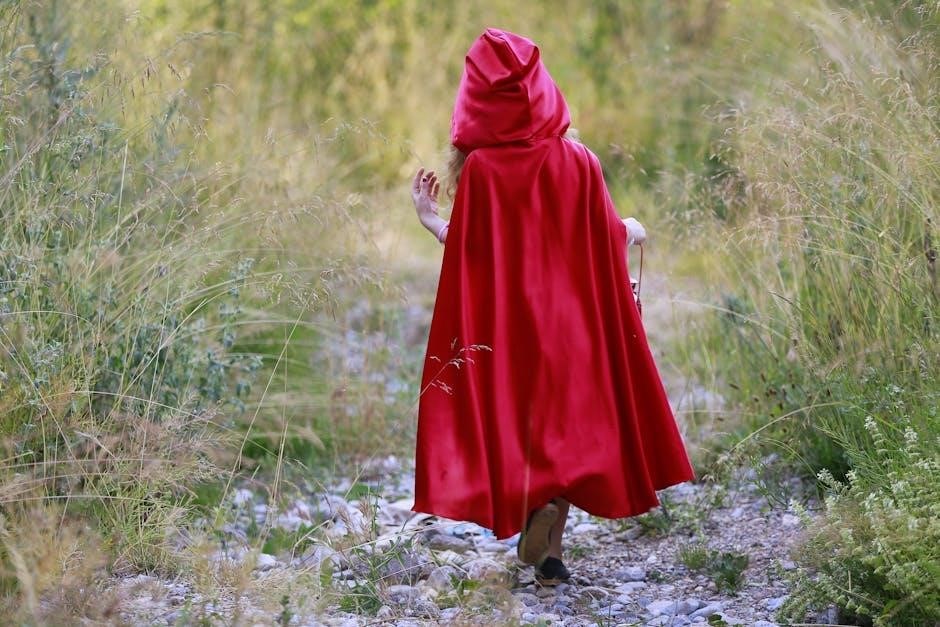
Comparison with Other Fairy Tales
The Three Little Pigs shares themes of deception and survival with tales like The Boy Who Cried Wolf and Little Red Riding Hood, featuring similar wolf antagonists and moral lessons.
10.1 Similarities with “The Boy Who Cried Wolf”
Both The Three Little Pigs and The Boy Who Cried Wolf feature deception and consequences. The wolf in both tales manipulates situations for personal gain, while the protagonists face harm due to their actions; Both stories emphasize honesty, responsibility, and preparedness, serving as moral lessons. The wolf’s cunning nature and the protagonists’ vulnerabilities highlight the importance of trustworthiness and foresight, making these tales timeless for teaching ethical values to children.
10.2 Differences from “Little Red Riding Hood”
The Three Little Pigs and Little Red Riding Hood differ in plot and moral focus. While both involve a predator (wolf) and innocent characters, The Three Little Pigs emphasizes preparation and hard work, as the pigs build houses to protect themselves. In contrast, Little Red Riding Hood focuses on deception and the dangers of trusting strangers. The pig characters actively shape their fate, unlike Little Red Riding Hood, who relies on external help, highlighting different lessons on survival and responsibility.
10.3 Common Themes in Fairy Tales
Fairy tales like The Three Little Pigs and Little Red Riding Hood share common themes, such as the struggle between good and evil, the importance of wisdom, and the consequences of choices. These stories often feature moral lessons, teaching children about responsibility, bravery, and the rewards of hard work. The use of anthropomorphic characters and symbolic elements, like houses and wolves, reinforces these themes, making them relatable and memorable for young audiences.
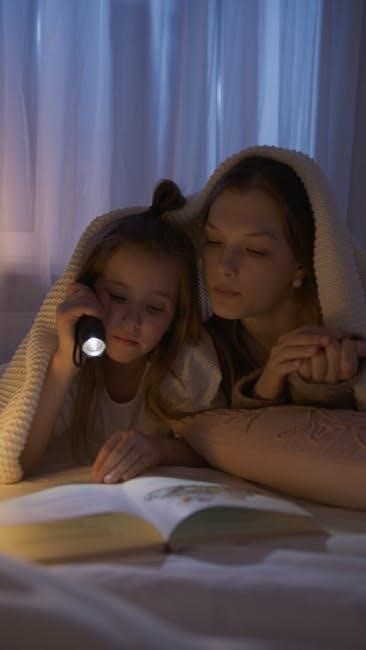
Impact on Pop Culture
The Three Little Pigs has inspired numerous references in movies, TV shows, and children’s media, cementing its place as a cultural icon with enduring appeal and modern interpretations.
11.1 References in Movies and TV Shows
The Three Little Pigs has been adapted into various films and TV shows, such as the 2009 Broadway revival of West Side Story, where the wolf’s role was reimagined. CBeebies’ Mr. Bloom brought the story to life through narrative and dance. Additionally, the tale has inspired animations and live-action productions, ensuring its timeless appeal. These adaptations often retain the core message of hard work and preparation while adding creative twists for modern audiences.
11.2 The Story’s Influence on Children’s Media
The Three Little Pigs has profoundly influenced children’s media, inspiring educational programs, interactive games, and storytelling tools. Its moral lessons and engaging plot make it a staple in early education. The story’s availability in PDF format has further expanded its reach, allowing teachers to incorporate it into curriculums. Its themes of hard work and preparation resonate with young audiences, ensuring its enduring popularity in children’s media across generations.
11.3 Memes and Modern Interpretations
The Three Little Pigs has become a cultural reference point, inspiring memes and modern reinterpretations. Its themes of preparation and consequences are humorously applied to real-life situations, making it a popular meme topic. Additionally, the story has been reimagined in various forms of media, from animated series to educational programs, ensuring its relevance in contemporary culture. Its timeless lessons continue to resonate, adapting to new platforms and audiences while retaining its original charm.
The Three Little Pigs remains a timeless tale, teaching valuable lessons about preparation and perseverance. Its availability in PDF ensures it continues to inspire future generations.
12.1 Relevance of the Story Today
The Three Little Pigs story remains highly relevant today, offering timeless lessons on hard work, preparation, and facing challenges. Its universal themes resonate across generations, making it a popular choice in schools and homes. The availability of the story in PDF format ensures easy access for modern readers. Its adaptability to various media and cultures further highlights its enduring appeal, solidifying its place in both education and entertainment.
12.2 Final Thoughts on the Three Little Pigs
The Three Little Pigs story remains a timeless tale, offering universal lessons on hard work, preparation, and wisdom. Its enduring popularity lies in its ability to captivate both children and adults, making it a valuable resource for moral education. The availability of the story in PDF format ensures its accessibility, allowing future generations to enjoy and learn from this classic narrative. Its relevance continues to grow, solidifying its place in children’s literature.
